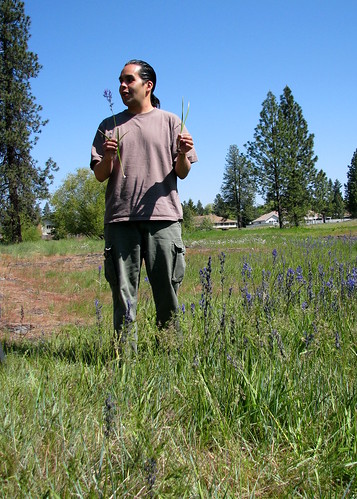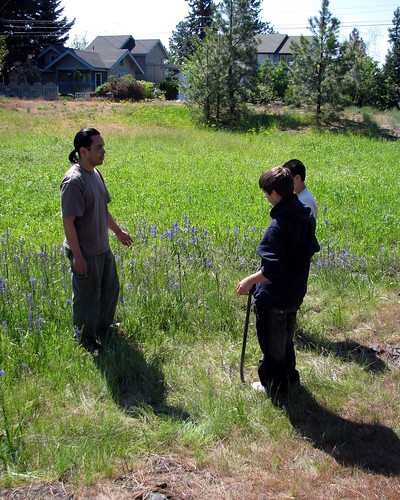Demonstrating the identifying features of camassia quamash, known more commonly as camas.
Yesterday morning, I had the opportunity to lead a small group of students in an etra-credit field trip to learn more about native plants. Only a handful of Dakota's classmates made the trip, along with their teacher, and two parents. Despite the small group, we had a wonderful experience.
I lectured briefly on the cultural history of the location, and then explained the traditional uses of brown camas. Perhaps one of the more fascinating bits of information about this plant is the cooking method used by early peoples. Since ancient times, Native people in this region prepared brown camas by cooking it in pit ovens for three days. But why three days? How did they arrive at that number?
Modern science sheds new light on this ancient practice. As it turns out, camas is filled with a complex sugar known as inulin, which is completely indigestible to the human body. A person could eat buckets of raw camas with no nutritional benefit whatsoever. However, if a person bakes camas for an extended period of time, about three days actually, the inulin breaks down into a simpler form that is nutritious and life-sustaining to humans.
Of course, our ancestors may not have explained their method in this manner, but they possessed this essential wisdom anyway. Some have suggested that they arrived at this complex understanding through a process of trial and error. Perhaps. But I also think they once possessed a much closer connection to the spirit of the plant. I know through personal experience that the plants and animals are able to communicate in ways that would surprise most modern people.
As an aside, I found an interesting account of the etmyology of the word camas. By the most reliable account I could find, it was originally a Nez perce word, first encountered in English by the Lewis and Clark expedition. Click HERE to read the account.
Yesterday morning, I had the opportunity to lead a small group of students in an etra-credit field trip to learn more about native plants. Only a handful of Dakota's classmates made the trip, along with their teacher, and two parents. Despite the small group, we had a wonderful experience.
I lectured briefly on the cultural history of the location, and then explained the traditional uses of brown camas. Perhaps one of the more fascinating bits of information about this plant is the cooking method used by early peoples. Since ancient times, Native people in this region prepared brown camas by cooking it in pit ovens for three days. But why three days? How did they arrive at that number?
Modern science sheds new light on this ancient practice. As it turns out, camas is filled with a complex sugar known as inulin, which is completely indigestible to the human body. A person could eat buckets of raw camas with no nutritional benefit whatsoever. However, if a person bakes camas for an extended period of time, about three days actually, the inulin breaks down into a simpler form that is nutritious and life-sustaining to humans.
Of course, our ancestors may not have explained their method in this manner, but they possessed this essential wisdom anyway. Some have suggested that they arrived at this complex understanding through a process of trial and error. Perhaps. But I also think they once possessed a much closer connection to the spirit of the plant. I know through personal experience that the plants and animals are able to communicate in ways that would surprise most modern people.
As an aside, I found an interesting account of the etmyology of the word camas. By the most reliable account I could find, it was originally a Nez perce word, first encountered in English by the Lewis and Clark expedition. Click HERE to read the account.
After my introduction, I allowed each student to dig up a few small camas bulbs. I was very happy to see their enthusiasm for the project.



No comments:
Post a Comment